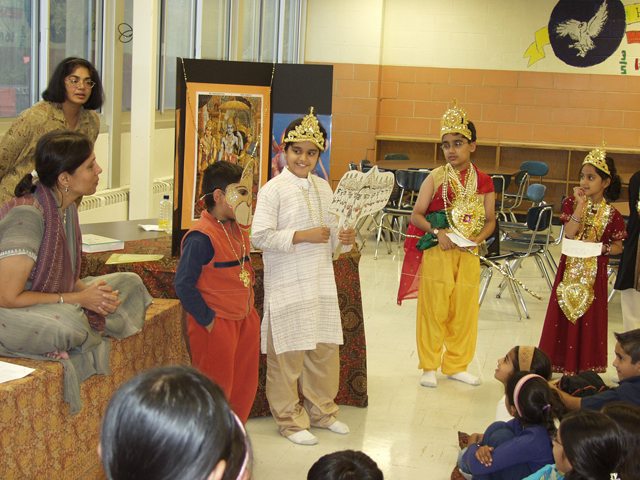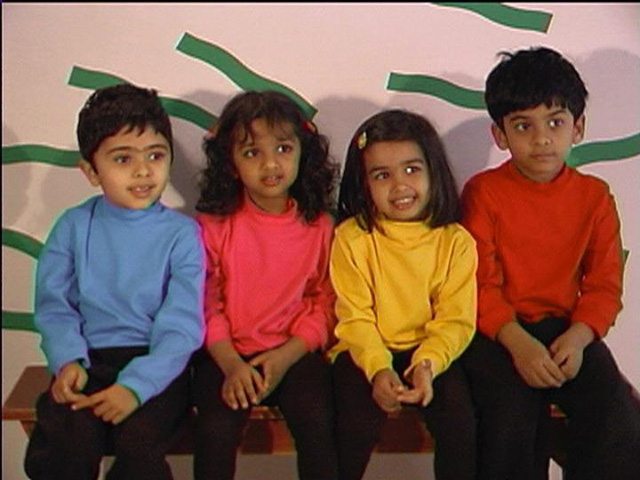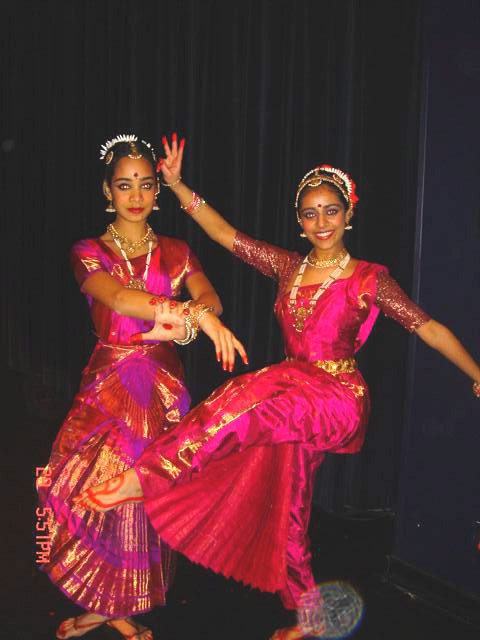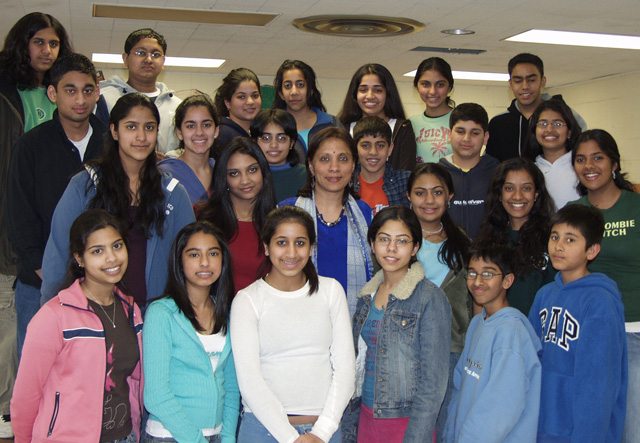
For Hindu children who grow up in India, their religion is all around them: it resounds from the bells of their neighborhood temple, in the stories told by grandparents and in the countless rituals and ceremonies which are a part of daily life in India. Living in a country that is 80 percent Hindu, they absorb their religion by osmosis, surrounded by large, loving extended families, by colorful festivals and holidays that permeate the seasons.
The Hindu way of life is in the very air they breathe.
But what about Hindu children born in fast-moving America where there are few markers of Indian life? Religion and culture are best absorbed in childhood, yet these children do not see Hindu culture echoed in the world around them, especially if they live in Small Town, USA where there may be few people who look or worship like them.
Well, now there’s good news for such families – they are not alone. A number of enterprising women – all of them mothers – have created innovative ways to pass on language and culture to American-born Indian children.
Meenal Pandya, a writer and consultant, has brought up two daughters in Massachusetts and successfully taught them about their religion and culture. She has written several books about Indian culture including children’s books on Holi and Diwali, but especially valuable to Indian parents is The Indian Parenting Book: Imparting Your Cultural Heritage to the Next Generation.
In it, she points out that Indian culture has evolved around the Hindu way of life that is based on three pillars: all creation is one family; every life is potentially divine; and there are many different paths to arrive at the same truth.
“Cultural parenting is, in essence, helping your next generation on the path of this journey,” she says. “On a more practical level, it is what you teach your children, how you teach your children and what you emphasize in your own life. Every act of a parent becomes a learning process and creates a cultural imprint for the child.”
For those struggling to impart Indian culture to their children without the help of extended family in a new country, the book provides a very useful blueprint for achieving success. Pandya discusses such topics as both parents working as a team, how to deal with a child’s resentment and even choosing the values you want to pass on.
She talks about the importance of the name you give your child and of imparting language, music and dance at an early age; they will always learn about the dominant Western culture they live in but what’s learnt in babyhood becomes inborn.
Pandya suggests exposing young children to the many religious ceremonies that take place in the community. “These activities offer a wonderful opportunity to teach our children the fundamentals of pooja rituals, some slokas and some religious stories. In fact, these events are so beautifully intertwined that it is as amazing to see how religion and social needs are seamlessly integrated within a society. For example, a Satyanarayan pooja can combine ritualistic aspects, storytelling and delicious food all in one event.”
As she points out, religious ceremonies and rituals are the backbone of Hindu life and it’s important to get children involved right from the start. She suggests familiarizing the child with pooja items and getting them involved in small gestures like chiming bells and introducing them to different gods and goddesses.
Other useful suggestions she makes are taking children frequently to India and showing rather than telling them about culture. She recently took her teenage daughters to the spice markets of Kerala where they learnt firsthand the value of different Indian spices to their health and looks – a much more compelling way to make them eat their food! She also suggests cooking meals when the children are around, rather than away at school, so that they can participate and the spices and aromas become an integral and natural part of their lives.
For parents who themselves may not enough about Hindu samskaras or ritual ceremonies and festivals, the book provides useful information on bringing Hindu culture into everyday life.
Out in Fremont, California, Ruchira Agarwal, who was in the IT industry, decided to venture into something totally new. The mother of two young kids, she has taken on the task of simplifying the learning of Indian languages for children born in this country. Indeed language is one of the most important gifts that parents can pass on to their children and this is so often lost when parents are not vigilant enough or don’t share a common language. So you have Baby Hindustani videos, which are modeled on the Baby Einstein videos – and not a single word of English is spoken on them!
These very creative language-learning tools teach basic words, colors and numbers, set to the music of Mozart, which is supposed to improve memory and language skills as well as visual development in toddlers. Now kids can learn Gujarati, Tamil, Telegu as well as Hindi words and phrases even as they sit on the sofa in front of the VCR.
 Another very useful tool is from MeeraMasi (Aunty Meera), a company created by two sisters, Sheetal Singhal and Sonali Herrera of San Jose, CA. Sonali, who can speak and understand Hindi, cannot write or read Hindi, so she decided to create books which would fill that need for second generation Indian-Americans who may be in the same boat. Sheetal, who is older and a Bharat Natyam dance teacher, had grown up in India and could read and write Hindi too. So she came up with original nursery rhymes and translated some popular American ones for the children’s book collection, the Khushē Manäo Series. It offers five books of popular rhymes along with an audio CD to assist with Hindi pronunciation and tone. It is targeted at kids from birth to five years, the formative years for learning a language.
Another very useful tool is from MeeraMasi (Aunty Meera), a company created by two sisters, Sheetal Singhal and Sonali Herrera of San Jose, CA. Sonali, who can speak and understand Hindi, cannot write or read Hindi, so she decided to create books which would fill that need for second generation Indian-Americans who may be in the same boat. Sheetal, who is older and a Bharat Natyam dance teacher, had grown up in India and could read and write Hindi too. So she came up with original nursery rhymes and translated some popular American ones for the children’s book collection, the Khushē Manäo Series. It offers five books of popular rhymes along with an audio CD to assist with Hindi pronunciation and tone. It is targeted at kids from birth to five years, the formative years for learning a language.
The cheerful illustrated books are written in Hindi with English transliteration, which is very useful for those who don’t know how to write the script. Next is Varnamala Geet, the equivalent of the ABC song – in Hindi. The sisters plan to do high quality books in other Indian languages too. Says Sonali, who is in marketing, “We think it’s great that there are books out there in English but we want to really stay true to our mission – producing materials in Indian languages.”
In Boston, Monika Jain, a journalist, and Leena Chawla, a software consultant – both mothers – got together to create a much-needed product for their children that was not out there in the market. Mainstream libraries had no magazine for South Asian children and the material available did not reflect the realities of these children. Once five-year-old Sejal came home asking when they would be celebrating Passover!
Kahani was born and this quarterly magazine (www.kahani.com) has quality writing and art by noted children’s writers and artists who themselves are south Asian.
While these stories are not particularly geared to religion, they celebrate India in all its diversity and place Indian names and faces and lives in the American landscape. A charming story tells of a girl’s first Kolu and yet another is about a young boy learning to adapt to his sari-clad grandmother and learning yoga from her.
The Kolu story for example is as much a Hindu story as it is an Indian story because it teaches children about their Indian culture. “So although we don’t write specific stories about any religion in particular, we touch upon all those cultures through our stories,” says Chawla. “ It’s a secular magazine but we do teach them about Indian culture, science, geography and history so that they can be proud of their Indian heritage.”
Jain emphasizes that Kahani is about contemporary story telling and art that the children can relate to. So in the Kolu story, the dolls on the Kolupadi or mantelpiece include a Japanese superhero called Ultra Man, a great favorite of her son’s. It brings culture into their realm in terms they can understand.
Kahani also fosters creativity in the children growing up in America. In the magazine, a mother, Sujatha Ramnani, shares how the family uses colored blocks to create Rangoli patterns and says, “One difference is in India it’s mainly a women’s affair but here my son and husband are equally involved.”
The magazine encourages children to be proactive by initiating a young writers’ short story competition and now the call has gone out for children to illustrate their stories, thus making children realize the importance of their lives and experiences.
Besides these great tools for teaching Indian children about language and culture, music and dance schools are coming up in many parts of the country with large Indian populations..
For many Indian children, it’s important that the mainstream knows and accepts their culture. In New York, noted Bharatanatyam dancer Swati Bhise has been teaching and performing for over 20 years and has taken Indian dance to scores of American public schools, teaching children from all cultures the music and dance of India.

In 2004 she founded Sanskriti Institute for Indian Culture with classes taking place at All Souls Church in Manhattan. The school integrates the ethos of Indian dance, music, literature and philosophy. While Bharat Natyam is the basis, the curriculum includes the teaching of Carnatic music, yoga, Hindi classes and Sanskrit slokas along with cultural history.
Many of the Indian parents who come are pleasantly surprised that it’s not just about dance but also about asanas, the navgrahas and even the Hindu iconography, be it in a temple or the Metropolitan Museum. Since the students are from many religions, Bhise and Bunty Sawhney, the director, teach about the Indian ethos but not any religion.
Indeed, the good news is that cultural organizations and schools are sprouting up everywhere, and a dance or music class is usually within reach. Rathi Raja, who is Director of the Young Indian Culture Group (YICC) in Long Island, NY, observes: “There are so many basement operations. For every one institution we see in the public eye, there are hundred mini organizations, which are just organizations of people doing something that they believe in.”
Raja’s Young Indian Culture Group, a not for profit organization, started with just 30 children 13 years ago and has grown to over 200 children being taught Vedic traditions, classical and folk dance, music, languages, yoga and Vedic traditions by over 25 teachers.. The classes are held at the Herricks Middle School, thus becoming part and parcel of the mainstream and a community resource.
She feels that that teaching native languages is as important as music and dance. “What is missing is an emphasis on language and without that, there is no depth to any of the other activities. You do Bharatanatyam, and the patron saint is Lord Shiva. If the child doesn’t have some ongoing education of the spiritual basis of that, then that education is incomplete.”
The Vedic curriculum at the center is called Vedic Heritage and it focuses on the symbolism in the Hindu tradition – units on Ramayana, Mahabharata and Bhagavad and also a 5-year program on the Bhagvat Gita, which starts with children in the middle school. “It’s a very solid program that takes up certain chapters of the Gita and through that really opens the window to the broad philosophical underpinnings of Hinduism,” says Raja. “ I find high school students are very satisfied in terms of the study of who they are and what their roots are. From that point they can take up the study for the rest of their lives.”
The center has a unique way of celebrating festivals through a combination of story telling and bhajans. It goes back to the ancient oral tradition and stories are told in a musical fashion emphasizing values, making a connection between the storyteller and the listeners.
“It touches the spirit of all these stories,” says Raja. “With all the automation and making Ramayana into shows and cartoons, children may know these stories but I don’t think the bhakti is there, so, in a sense, we have to go back to our roots, to the ancient traditions of story-telling to make human connections with children and families, where it helps bhakti to flower.”
There are bhajans for the younger children and chanting for the older ones. As Raja observes, “In our tradition there is such a vast array of prayers you can never run out of them!” There is also a ‘Mommy and Me’ program modeled on the mainstream programs, but here, mothers and their pre-school children sing Indian rhymes, the national anthem and do yoga, prayers and Indian crafts. Says Raja: “It’s just a lot of fun – it’s a cultural connection.”
Raja points out that credit has to be given to the Indo-Guyanese community, which does a lot to keep Hindu culture flourishing through classes, programs and concerts. The Indian-American community, though, needs to pick up on the momentum and be more aware in building for the future, like the Jewish community. The Indian community, while building many temples, has generally not been into institution building.
“Every synagogue has a rite of passage program for all the milestones of a child’s life – It’s a whole cycle of life approach and children grow up and then come back with their children,” says Raja. “Their system works and I think it’s because they’ve institutionalized things and if a new person comes in, there are places where they could go.”
Hinduism, being so elastic and expansive, has less structure and there are no schools for Hindu culture. Now some Hindu temples in the U.S. have started outreach, and have incorporated classical dance, sitar and tabla classes along with yoga, Vedic traditions and language for their congregations. In the U.S. there are over 160 temples, small and large – the majority from South India – be it the Hindu Temple Society of North America in New York, the Venkateshwara Temple in Pittsburgh, or the Meenakshi Temple in Texas.
In fact, many Hindu temples have taken on the tasks of imparting Indian classical dance and music, regional language lessons and yoga to the children. For example, the Ganesha Pathshala at the Hindu Temple in Flushing runs religion classes as well as language classes, teaching Hindi, Telegu, Tamil, Kannada and Sanskrit to children.
But the temples are still scattered and far-flung, and what Raja would like to see is a community center model, a gathering place available to all members of the family to practice whatever interests them, from dance to music to meditation, a space where everyone from children to seniors can be in touch with their culture.
“Language, music, dance all have their place but the concept of a community is very important,” she says. “In areas where you have a lot of Indians it’s good to have an organization that can serve the community. The children will grow up seeing Indian culture in their mainstream school and feel a connection to the people who run it and can share it with their peers – its bringing role models in front of them.”
Other Hindus could also take inspiration from South Indian families.
Music and dance is part of the family tradition in South India – every daughter and son learns it right from childhood. Many go to India in the summer holidays where their children may take classes in Carnatic music and dance.
The Hindu children who grew up in America 20 years ago had few resources and were basically alone in a mainstream environment. Now many of them are having children of their own, and for them it’s a challenge to pass on something they never had themselves – in many cases, language and rituals have been lost. So these books, CDs videos and classes are a useful tool for them.
. Many of today’s young adults are so completely mainstreamed that they are lost to the culture, especially if they did not see it in their own family. “So much is dependent on individual families,” says Raja, “A culture can’t survive if it’s so based on individual performance – institutions, including temples, have to make these rituals available in a systematic fashion.”
The large Indian population in the US now makes it possible for the community to have many more resources. Young families can find others like themselves who have similar backgrounds and needs. Collaborating with each other and forming community centers seems the ideal.
It is important to catch them young. As Pandya points out, “ That is the only time window you have as parents. The minds of children under the age of 10 (this age may vary but between the ages of 7 and 10 they start asserting their own logic) are like a sponge, and they absorb everything you give them. Culture and religion are very subtle -unlike say, learning a new sport – and subtle things are absorbed – not given – from the environment.”
She points out that younger children are more likely to spend more time with their parents and at home; the older they get, the outside influence will start weighing more into their lives.
Hindu parents can expose their children to the rich traditions of dance and music and language and make it an intrinsic part of their lives, rather than something that is a tacked on option. If children absorb the culture even as they learn to walk and talk and dream, it will not be something alien to them; it will belong to them, like the family’s precious silver deities and pooja paraphernalia, to be cherished and passed on to the next generation.
HOW TO MAKE THEM LOVE THEIR CULTURE
Meenal Pandya shares 6 tips for parents.
1. Be proud yourself and know why you are proud. False pride sounds hollow to children.
2. Live the values you are proud of. (If you say that our culture has great family value but your children do not see you doing much for your larger family, the value may not go too far in their mind)
3. Teach them your language. Language is the “carrier” of any culture.
4. Try to give them at least one Indian art (music, dance). Indian art is very closely related to both religion and culture. It is a “fun” way for children to get absorbed in the culture.
5. Expose them to the beautiful aspects of the culture. Many large cities have collections of Indian art, for example in their museums. Take them to such museums. Read them books. Take them to age-appropriate musical or dance concerts.
6. Lastly, do not overdo it.
© Lavina Melwani
Photos – Courtesy: The Culture Club, Baby Hindustani and Sanskriti Foundation.


2 Comments
Living between two worlds is always a constant dance but I think most immigrants finally get it and make their peace with the push and pull of two cultures. People are very resourceful and generally fashion their own identity to accommodate their different roles.
It is indeed challenging to bring up children in America because we as first immigrants to this country would like to keep the things as they were back home. What i particularly noticed is the cultural difference in treating our elders with respect,the thin line between boundaries and individual freedom etc…
In India once the relationship is tied to your karma, you manage them your entire life no matter what , boundaries that divide people in to more individualistic and self centered lifestyle in the west is something that is anathema to most of us because, we mostly survived and lived our entire life by sacrificing for the loved ones. In India life is all about loving each other just like Karan Johar said!